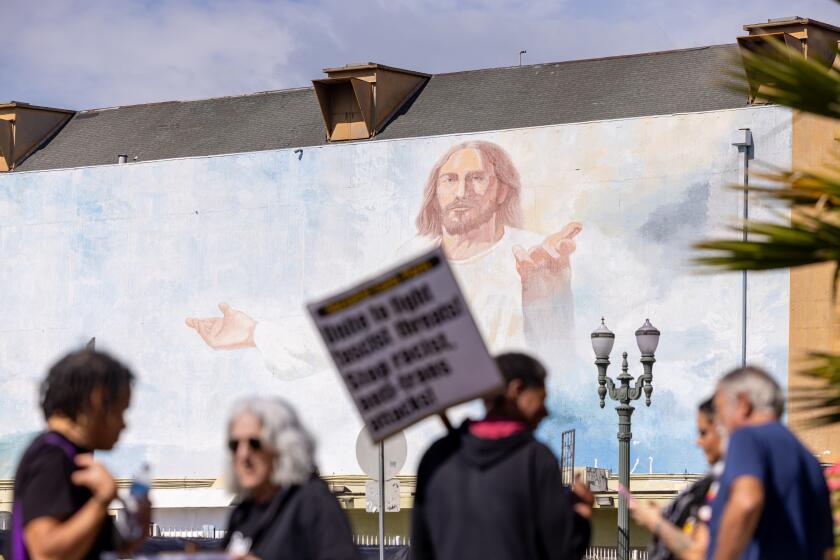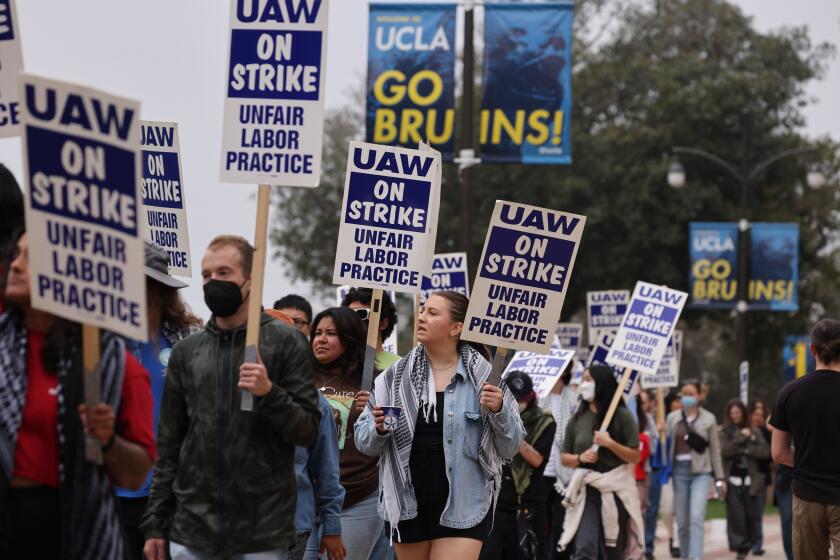Southland, Not Stanford, to Get Reagan Library
The Ronald Reagan Presidential Library will not be built at Stanford University after all.
Faced with mounting opposition from Stanford faculty leaders and local property owners, trustees of the Ronald Reagan Presidential Foundation announced in Washington on Thursday that the library will be located in Southern California instead.
Gary L. Jones, executive director of the foundation, said the trustees decided that the Reagan Library and a proposed public affairs center should be at the same site.
“Since, regrettably, this cannot be accommodated at Stanford University, these facilities will be located in Southern California at a site presently being determined,” Jones said on behalf of the nine trustees. “We express our appreciation to the Stanford University Board of Trustees for their cooperation during past negotiations regarding the library.”
‘We’re Disappointed’
In a joint statement, Warren Christopher, chairman of the Stanford Board of Trustees, and Stanford President Donald Kennedy said: “We were proceeding diligently and on schedule with our planning for the library, and so we are naturally disappointed with the decision. . . .”
Kenneth Arrow, professor of economics and chairman of the Stanford Faculty Senate, said the faculty “regarded the library as a valuable research resource. It is a source of regret that it will not be located as conveniently for the scholars and students who would use it.”
However, behind these polite statements lies a history of several years of tense and sometimes hostile exchanges between the Reagan Presidential Foundation and various elements of the Stanford community.
The foundation’s chairman is W. Glenn Campbell, who is also director of the Hoover Institution, a conservative library and “think tank” on the campus with which liberal faculty members often have found fault.
The foundation vice chairman is Atty. Gen. Edwin Meese III. Secretary of Energy John S. Herrington, former Atty. Gen. William French Smith and former National Security Adviser William P. Clark are among the trustees.
At first, the foundation proposed a complex which was to include the library, a museum and a public policy center, to be administered by the Hoover Institution.
After lengthy negotiations, Stanford trustees agreed in June, 1985, that the library and a small museum could be built on a 20-acre site in the foothills overlooking the campus, but they refused the Hoover-run policy center.
Campbell has taken a leave of absence from Hoover to raise about $100 million for the library, museum and policy center.
Although Stanford trustees and administrators repeatedly emphasized that the library had been accepted as a valuable resource for historians and other scholars and not as a tribute to President Reagan, some faculty members remained disturbed.
“The library presents a very unfortunate set of problems,” Gordon Craig, professor emeritus of history and former chairman of the Faculty Senate, said in an interview with The Times several weeks ago. “It does appear to put a conservative stamp on the university that could, in the long run, be damaging to our reputation.”
Faculty leaders were upset because planning for the library proceeded with very little faculty participation.
As architectural drawings and other plans became available, many faculty and staff members came to think that the library would be larger and more intrusive than they first believed. This was especially true of professors and staff members who live in the foothill area near the planned location.
Other residents also complained about the proposed size of the library and the fact that it would be used for public gatherings that would generate extensive traffic. Earlier this year, more than 3,500 area residents signed petitions opposing the foothill location.
In an April 14-15 referendum, Stanford students voted 3,404 to 1,428 to ask for an alternate site.
Concerns about the proposed buildings deepened after a January press conference in Washington, at which architect John Stubbins displayed drawings of the proposed library that showed it dominating the campus.
Stubbins also offended many members of the Stanford community by saying he intended to use building materials superior to the “very ugly” sandstone that characterizes Stanford architecture.
Others became agitated when Campbell, in the 1986 Hoover Institution annual report, said that the Stanford trustees’ agreement to accept the library meant that the “entire university,” not just Hoover, now could “boast of a Reagan connection.”
The Faculty Senate sharply criticized Campbell for these remarks.
“Such public comments by a university officer run counter to the nonpartisan rationale offered by the Board of Trustees for siting . . . the library on this campus,” the Senate said.
Campbell fired back that his comments were “a statement of fact and did not constitute a partisan endorsement of the President’s policies.”
“Rather than accept a statement of pride about the university’s connection with the presidency, the Faculty Senate has chosen to pass a resolution against it,” he said.
On April 2, Christopher, making an unprecedented appearance before the Faculty Senate, said it would be “very difficult” to move the library to another campus location “unless there is a substantial change of circumstance.”
Christopher said he hoped the faculty would “understand where we stand as a great university, having made commitments to the President of the United States and really to the country as a whole.”
But the senate, by a vote of 26 to 4, then passed a resolution urging the Board of Trustees to scale down the library or move it farther from the center of the campus.
This resolution appears to have been the final straw for the Reagan Presidential Foundation trustees, who have responded by washing their hands of Stanford altogether and turning instead to Southern California as a home for this memorial to the President.
Times staff writer Robert Gillette contributed to this story.
More to Read
Start your day right
Sign up for Essential California for news, features and recommendations from the L.A. Times and beyond in your inbox six days a week.
You may occasionally receive promotional content from the Los Angeles Times.






